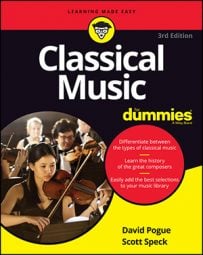But classical music in the 21st century differs from classical music of the 20th century in one important respect: It sounds less modern than the older music did. Here you can discover how composers lost their harmonic bearings a century ago — and recently found their way back again.
Abandoning harmony
In the 20th century, nearly all composers who wanted to be taken seriously experimented with new harsh discords and unsteady rhythms. On the assumption that all the possibilities of harmony had already been exhausted in the Romantic era, they decided to try something different. Composers threw themselves into the pursuit of atonality, or dissonance, even going so far as to embrace serialism — the idea that every single note had to be used with equal frequency.A few great masterpieces came out of this 20th-century ban on tonality — but really, only a few. It’s impossible to overstate the peer pressure that composers felt to abandon traditional harmony. Many extremely talented classical composers with traditional harmonic or melodic tendencies were absolutely stymied by this temporary mass hysteria. Nobody knows what works of genius could have resulted had these composers been able express themselves fully.
Returning to sanity
The fact is, traditional harmony is based on the series of natural overtones, and that’s why it sounds beautiful to many people’s ears. In the 21st century, classical composers are once again turning to the tried-and-true harmonies that made the music of earlier centuries so successful. (Of course, popular music never abandoned these harmonies; that’s one reason why it’s called popular.)Today’s groundbreaking classical composers are more likely than not to use tonality — and it’s no surprise that they are finding a wider audience than before.
Classical composers are also incorporating today’s dance forms into their music — just as Wolfgang Amadeus Mozart used the minuet, Johann Strauss used the waltz, Gustav Mahler used the Ländler, and Leonard Bernstein used the mambo.
The contemporary composer Mason Bates worked as a DJ for years before creating compositions that juxtapose the orchestra with groovy synthesized dance jams. Composers as different as Aaron Jay Kernis, Jennifer Higdon, Kenji Bunch, Osvaldo Golijov, and Michael Abels have been known to incorporate strains of jazz or rock into their work.
Just as interesting, in the 21st century, is the interface between concert music and music for movies, TV, and video games. John Williams, Oscar-winning composer of countless world-renowned film scores, has also lent his signature style to several beautiful concert works — most notably concertos for harp, bassoon, tuba, and cello, each with orchestra. And the Grammy-nominated video game composer Austin Wintory is making his mark in the concert hall, as well.
These new developments are welcome. Once upon a time there was no difference between classical and popular music. There was only music — the music of the people. The craziness of the 20th-century music intensified charges of elitism that sent people flying from concert halls in droves.
Today’s audiences are much more likely to stay. The public is becoming more interested in what the composers are doing. Composers are relating to their listeners, and vice versa. Slowly, classical music is starting to become the music of the people once again.
Listening to the music of the 21st century
Talented young composers are whipping up delicious new creations all the time. Check out the offerings of your local orchestra, or tune in to any classical radio station, for a few gorgeous examples. But you can’t go wrong with these beautiful pieces, all written since the turn of the millennium:-
Michael Abels: Delights and Dances for string quartet with orchestra
-
Mason Bates: The B Sides
-
Kenji Bunch: Symphony no. 1 (Lichtenstein Triptych)
-
Anna Clyne: Night Ferry
-
Osvaldo Golijov: Mariel
-
Jennifer Higdon: blue cathedral
-
Aaron Jay Kernis: Color Wheel
-
Kevin Puts: Piano Concerto (Night)
-
Christopher Theofanidis: Rainbow Body
-
John Williams: Harp Concerto (On Willows and Birches)

